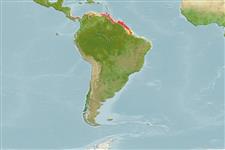| Native range | All suitable habitat | Point map | Year 2100 |

|
| This map was computer-generated and has not yet been reviewed. |
| Mugil incilis AquaMaps Data sources: GBIF OBIS |
Length at first maturity
Lm ?, range 24 - ? cm
Utilização humana
Pescarias: pouco comercial
Phylogenetic diversity index
(Ref. 82805)
PD50 = 0.5000 many relatives (e.g. carps) 0.5 - 2.0 few relatives (e.g. lungfishes)
Nível Trófico
(Ref. 69278)
2.0 ±0.1 se; Based on diet studies.
Resiliência
(Ref. 69278)
Elevada, tempo mínimo de duplicação da população menor que 15 meses (Preliminary K or Fecundity.)